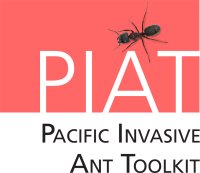Bicoloured pennant ant
|
stings |
harms crops |
harms wildlife |
lives on ground |
day active |
|
Scientific name: Tetramorium bicarinatum Size: approximately 4 mm Colour: light yellow-brown to red head and thorax, and black abdomen General description: this medium-sized ant is strongly bicoloured with a lighter body and dark abdomen Habitat and nesting: the bicoloured pennant ant nests in exposed soil or under stones, nests may also be found in rotting wood or logs, under tree bark or in plant stems. Rate of spread: unknown. Distribution: see our invasive ant distributions page for the worldwide distribution of the bicoloured pennant ant. Reproduction: no information found. For a detailed description and identification of bicoloured pennant ants: PIAkey: Tetramorium bicarinatum (see diagnostic characters tab) AntWeb: Tetramorium bicarinatum Social, agricultural and environmental impacts of the bicoloured pennant antThe bicoloured pennant ant is not aggressive but occasionally stings humans, and can be annoying if it is present in the home or garden. This ant farms sap-sucking insects such as scale insects, but is considered a minor agricultural pest. It has been associated with population explosions of a scale insect on small Australian islands, which lead to massive die-backs of the tree Pisonia grandis, important seabird nesting sites. |
Bicoloured pennant ant worker (© Eli Sarnat, Creative Commons Attribution, Share Alike CC BY-SA Licence) Bicoloured pennant ants foraging on peanut butter in Fiji, Vimeo video (© Eli Sarnat, Creative Commons Attribution, Share Alike CC BY-SA Licence) |
|
Bicoloured pennant ant worker (© Alex Wild) |
Bicoloured pennant ant walking on a tree trunk (© Eli Sarnat, Creative Commons Attribution, Share Alike CC BY-SA Licence) |
Information sources
AntWiki, Bicoloured pennant ant
Global Register of Introduced and Invasive Species (GRIIS)
Landcare Research Manaaki Whenua Ant Factsheet, Bicoloured pennant ant
PIAkey, Bicoloured pennant ant
Wetterer. 2009. Worldwide spread of the penny ant, Tetramorium bicarinatum (Hymenoptera: Formicidae). Sociobiology 54(3): 1-20
Content reviewed by Eli Sarnat, Antwork Consulting, LLC, June 2017



